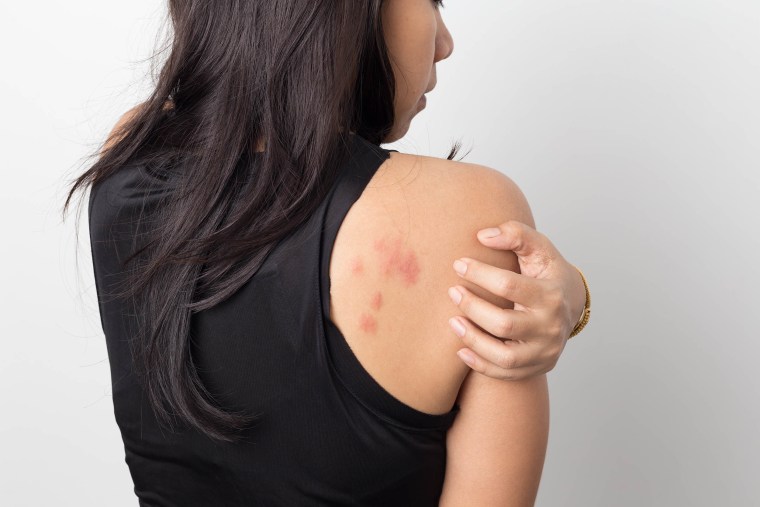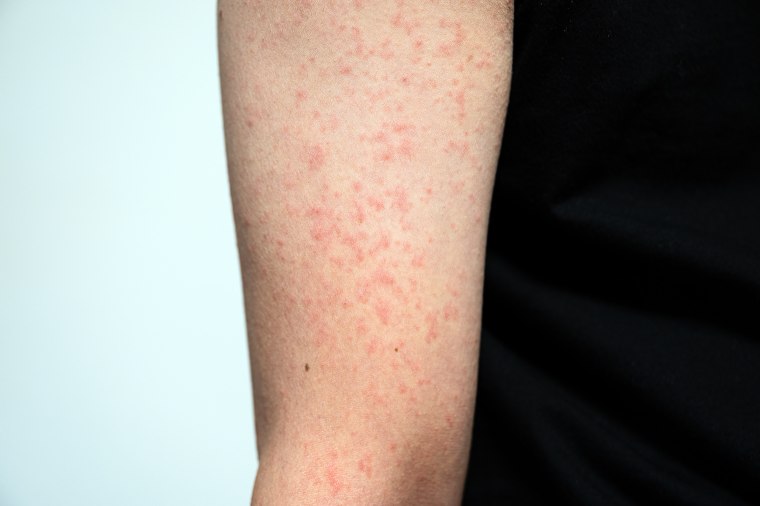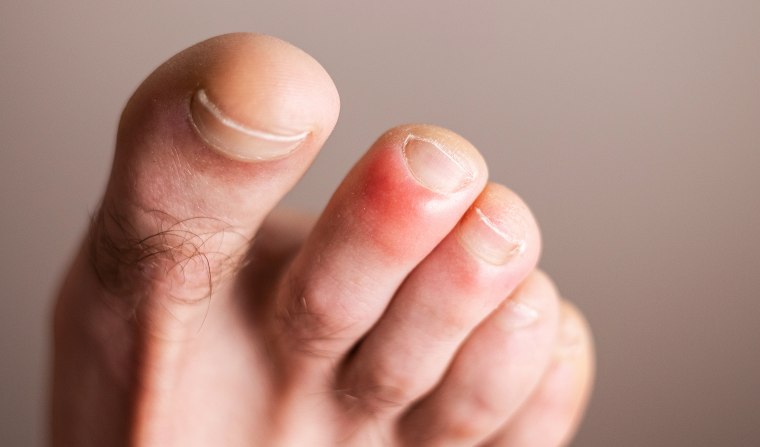We usually think of COVID-19 as a viral illness that causes respiratory symptoms, like congestion, sore throat and a cough. But, like a surprising amount of other viruses, the coronavirus can also lead to annoying, itchy and even painful skin rashes.
When you see a rash as part of a virus, you're not really seeing the virus go into your skin directly, Dr. Andrew Walls, assistant professor of dermatology at Harvard Medical School, tells TODAY.com.
Watch NBC6 free wherever you are
Instead, what you're usually seeing "is the virus activating your immune system to a high degree as it's combating the virus," he explains. While it's not a common symptom of COVID, a rash is yet another manifestation of your body's overall immune response to the virus.
And viral rashes aren't unique to COVID-19; other viral illnesses such as measles, chickenpox and hand, foot and mouth disease frequently include a rash.
Get local news you need to know to start your day with NBC 6's News Headlines newsletter.
A rash related to a viral infection is sometimes called a viral exanthem, Dr. Jeffery Gehlhausen, Ph.D., assistant professor of dermatology at the Yale School of Medicine, tells TODAY.com. And the term encompasses an entire category of well-known skin conditions. "This (link) is something that we've known about for, honestly, centuries," Gehlhausen says.

So, if you develop a rash as a symptom of COVID-19, you certainly aren't the first. Here's what to expect — and when to talk to your doctor.
Health
COVID skin rashes
Hives
Hives, also called urticaria, can be related to allergies. But they also appear after a viral infection, including COVID-19.
The condition can present as raised, itchy red, pink or flesh-colored bumps. They can occur in isolated patches or large clusters. And they can appear pretty much anywhere on the body, including your back, chest, legs and face, Walls says.
Hives also "move around your body quite a bit," Walls says. You could have hives for several days, but the patch of hives may move from area to area, he adds.
When hives are related to a virus, they tend to show up near the end of your infection, Walls says. The timing typically goes like this: Someone feels pretty sick and develops a fever. Then, when the fever breaks and it seems like they're turning a corner, that's when the rash starts to show up, Walls says.
Hives on their own or even with COVID-19 are not necessarily worrying, Gehlhausen says. If your hives require treatment, the first-line option is antihistamines, he explains.

Morbilliform rash (measles-like)
A typical viral exanthem is a rash made up of smooth, raised pink dots which can collect into larger patches, Walls says. The rash tends to start on the chest or back. Then, over a few days, it spreads to the extremities. (Some people only have a small area of their body covered while others have very large areas with rash.)
The rash will then reach a peak and “kind of fade away and peel, almost like a sunburn,” Walls says. For some, the rash is completely asymptomatic. But for others, it's very itchy, he adds.
One specific type of viral exanthem that dermatologists have seen with COVID is a morbilliform rash, meaning a measles-like rash. Measles rashes tend to look like small raised bumps that eventually coalesce into larger rashes, which can affect much of the body, before gradually fading away, as TODAY.com explained previously.
Coxsackie-like rash

Dermatologists have also seen COVID-related rashes that resemble those caused by the Coxsackie virus, also called hand, foot and mouth disease.
"These are fixed, small, painful, sometimes itchy oval blisters that develop on the hands, feet and the inside of the mouth," Walls explains, "often without a whole lot of rash elsewhere."
However, this is an "uncommon skin manifestation for COVID," Walls adds.
More recently, some strains of the Coxsackie virus have caused "more unusual rashes that may affect a larger body surface area," Gehlhausen says. In other cases, the rash may affect less common areas, like just appearing on the buttocks, he adds.
"Obviously, COVID has evolved over time," Gehlhausen says, "so you may see different distributions of the rash as a result of that."
COVID toes
You may remember a lot of talk about "COVID toes" early on in the pandemic. But it's not something dermatologists see a lot of these days, the experts say.
Chilblains — the technical term for COVID toes — is a skin condition that seemed uniquely linked to COVID and not to other viruses, Walls explains. "Sometimes it was linked to autoimmune diseases ... and it was thought to be associated with cold exposure," he adds.
The condition causes small areas of skin on the feet and hands to become swollen, itchy and painful, the Mayo Clinic says. The affected areas may also blister and become temporarily discolored.
Today, experts don't see COVID toes very often, they tell TODAY.com. That could be because people have stopped reporting it, the virus has mutated and is no longer causing the issue, or there was never a link to begin.
For now, "researchers are still looking at whether the swollen, discolored toes are caused by COVID-19," the American Academy of Dermatology says. "It’s possible that COVID toes develop when the person’s immune system reacts to the virus that causes COVID-19."
Vasculitis

Vasculitis is an autoimmune condition caused by inflammation of the blood vessels, an it can present as a rash.
Experts have seen some cases of vasculitis with COVID-19, particularly small cell vasculitis, which is the "least destructive" version of the condition, Walls says.
We know that SARS-CoV-2 can affect the cardiovascular system and make blood clots more likely, Gehlhausen says, so it's not surprising that we see vascular rashes in some patients. Generally, he says, vasculitis-type rashes occur in people with more severe infections.
Small cell vasculitis has been linked to many other conditions as well, including bacterial infections (even strep throat) as well as antibiotics and other medications, Walls says. "A huge array of things have triggered small vessel vasculitis in people," he explains.
Thankfully, the condition typically appears as a single episode that fades away on its own. But some people have cases that linger for months or recur down the line, Walls says.
Can COVID trigger or exacerbate other skin issues?
In addition to causing skin rashes, COVID-19 infections can also exacerbate or trigger a recurrence of pre-existing skin issues you may have.
That includes chronic skin conditions like psoriasis and eczema, the experts say. Interestingly, these can also flare after a COVID-19 vaccine, Gehlhausen says.
Illnesses, including COVID, are also known to trigger conditions such as shingles and cold sores due to HSV (herpes simplex virus), Walls says. These conditions "like to reactivate when something else is running you down anyway," he explains, which could be not getting enough sleep, stress in your personal or professional life or another illness, like COVID.
COVID skin rashes in children
Kids can get skin rashes due to viral infections, including COVID-19. In fact, children are "a little more prone to these skin reactions with viruses than adults are," Walls explains.
"Kids who are experiencing these viruses for the first time are going to be prone to getting these sort of things," Gehlhausen explains. For instance, dermatologists see a lot of kids with various forms of hives-like rashes, such as urticaria multiforme, alongside a viral infection, he says.
When to see a doctor for COVID skin rashes
"If you have a rash and COVID, it is absolutely worthwhile to go to see your primary care physician and discuss it with them," Gehlhausen says.
That said, if you have one of the more common rashes — like hives or a measles-like rash — those aren't necessarily "anything scary or concerning," he adds. "They're just types of rashes we know are associated with COVID, so it wouldn't prompt us to manage the virus any differently."
And, if it's on the milder end, you may be able to treat it at home with over-the-counter antihistamines or pain medication.
If your rash is severe, covers a large area of your body or is especially painful or itchy, you should definitely check in with a doctor or dermatologist, Walls says. They may be able to prescribe medications, like topical antihistamines or steroids, to help your skin heal.
The other concerning scenario is if you are generally feeling very unwell along with the rash. For instance, if you have a bad headache, high fever and trouble breathing and a rash shows up, Walls recommends checking in with a health professional.
This story first appeared on TODAY.com. More from Today:



